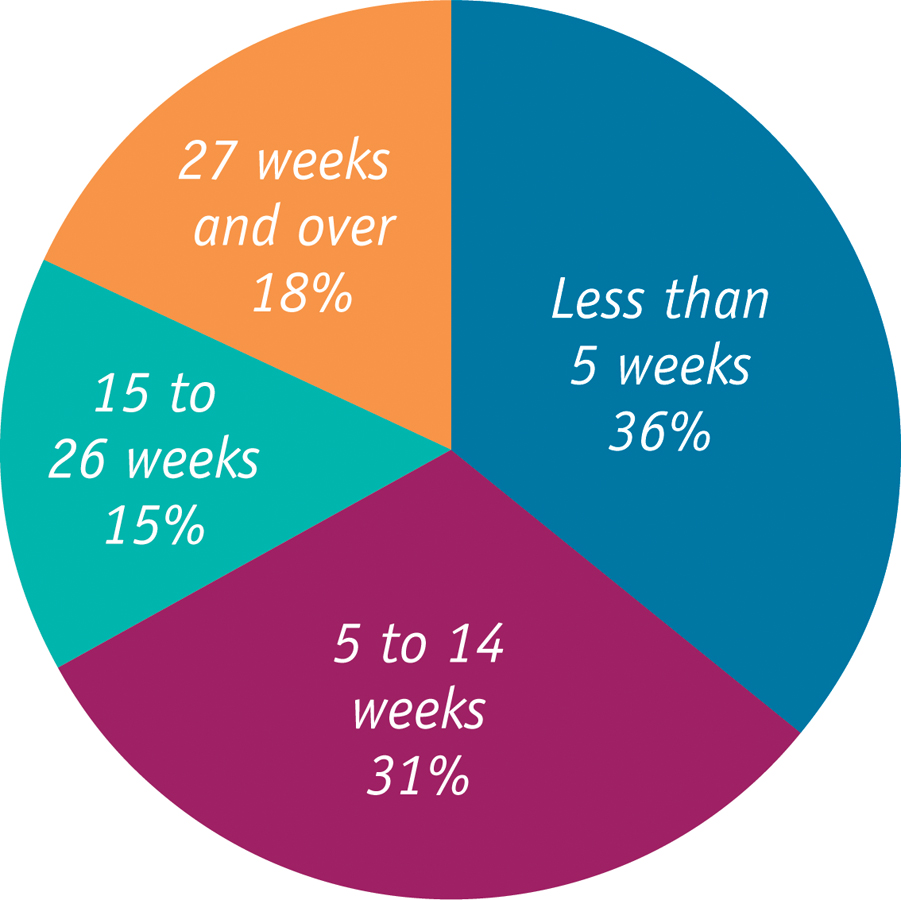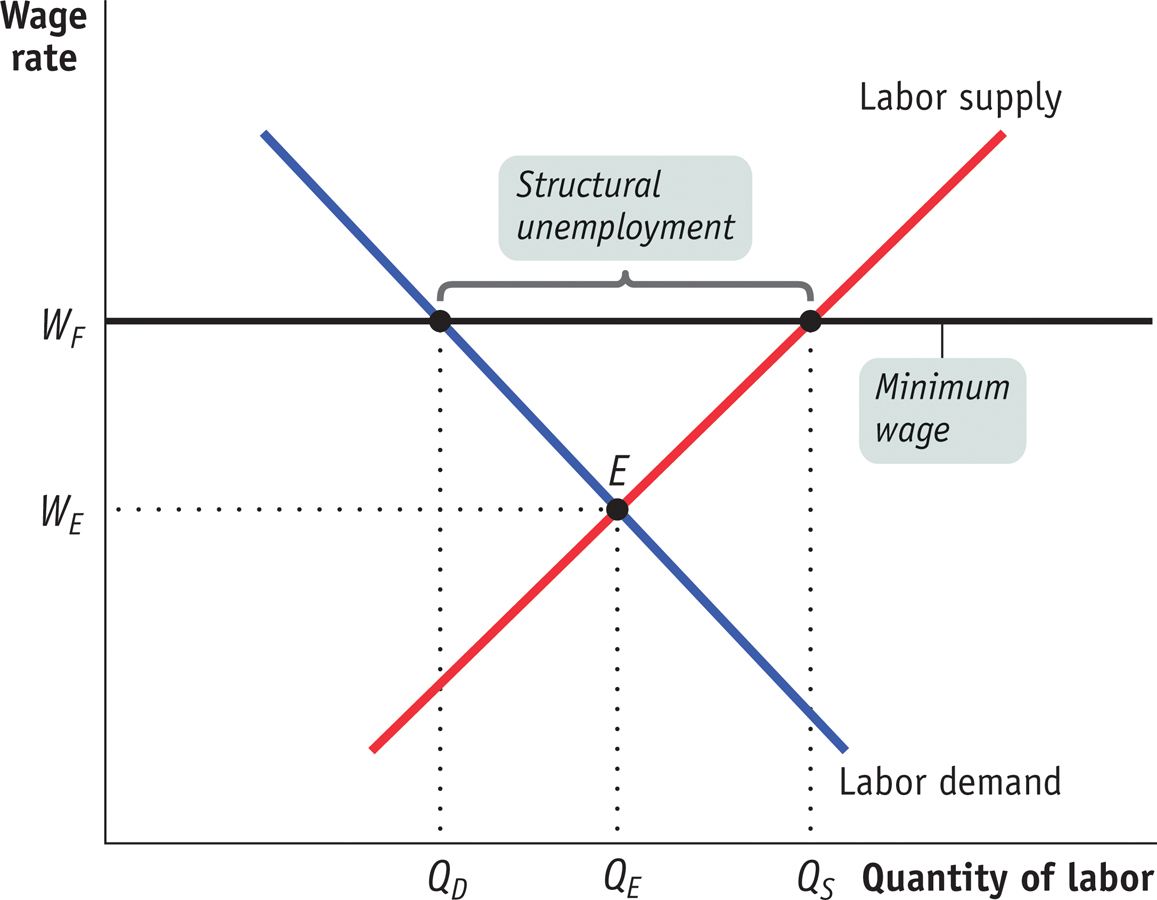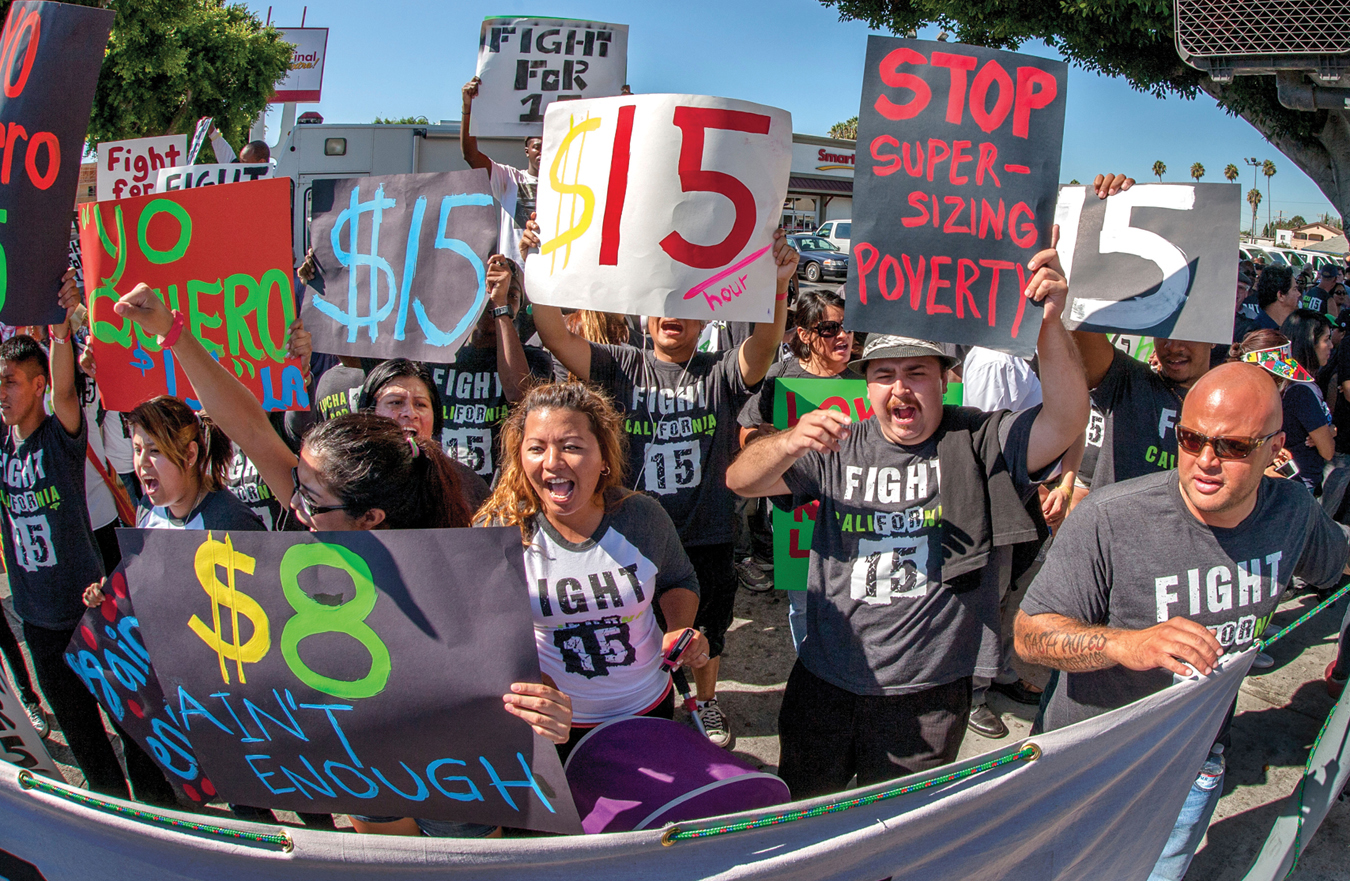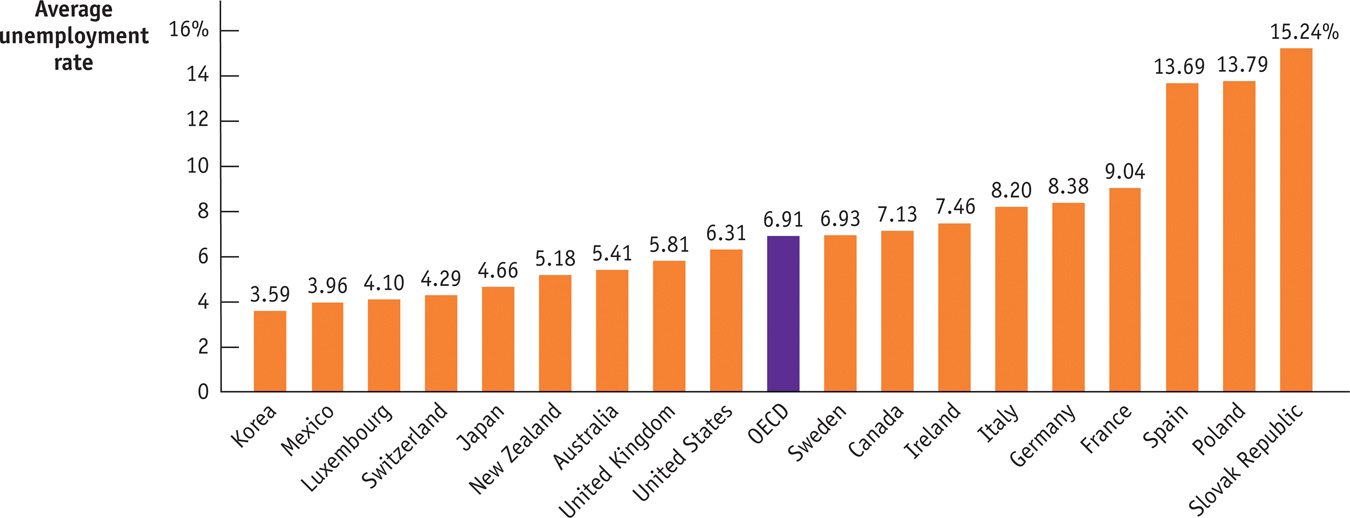1.2 14Categories of Unemployment

WHAT YOU WILL LEARN
 The three different types of unemployment and their causes
The three different types of unemployment and their causes
 The factors that determine the natural rate of unemployment
The factors that determine the natural rate of unemployment
Fast economic growth tends to reduce the unemployment rate. So how low can the unemployment rate go? You might be tempted to say zero, but that isn’t feasible. Over the past half-
How can there be so much unemployment even when many businesses are having a hard time finding workers? To answer this question, we need to examine the nature of labor markets and why they normally lead to substantial measured unemployment even when jobs are plentiful. Our starting point is the observation that even in the best of times, jobs are constantly being created and destroyed.
Job Creation and Job Destruction
Even during good times, most Americans know someone who has lost his or her job. The U.S. unemployment rate in July 2007 was only 4.7%, relatively low by historical standards, yet in that month there were 4.5 million “job separations”—terminations of employment that occurred because a worker was either fired or quit voluntarily.
There are many reasons for such job loss. One is structural change in the economy: industries rise and fall as new technologies emerge and consumers’ tastes change. For example, employment in high-
Poor management or bad luck at a company also leads to job loss for employees. For example, in 2005 General Motors announced plans to eliminate 30,000 jobs after several years of lagging sales, even as Japanese companies such as Toyota announced plans to open new plants in North America to meet growing demand for their cars.
Continual job creation and destruction are a feature of modern economies, making a naturally occurring amount of unemployment inevitable. Within this naturally occurring amount, there are two types of unemployment—
Frictional Unemployment
Workers who spend time looking for employment are engaged in job search.
Workers who lose a job involuntarily due to job destruction often choose not to take the first new job offered. For example, suppose a skilled programmer, laid off because her software company’s product line was unsuccessful, sees a help-
Frictional unemployment is unemployment due to the time workers spend in job search.
Economists say that workers who spend time looking for employment are engaged in job search. If all workers and all jobs were alike, job search wouldn’t be necessary; if information about jobs and workers were perfect, job search would be very quick. In practice, however, it’s normal for a worker who loses a job, or a young worker seeking a first job, to spend at least a few weeks searching.

Frictional unemployment is unemployment due to the time workers spend in job search. A certain amount of frictional unemployment is inevitable due to the constant process of economic change. Even in 2007, a year of low unemployment, there were 62 million “job separations,” in which workers left or lost their jobs. Total employment grew because these separations were more than offset by more than 63 million hires. Inevitably, some of the workers who left or lost their jobs spent at least some time unemployed, as did some of the workers newly entering the labor force.
Figure 14-1 shows the 2007 average monthly flows of workers among three states: employed, unemployed, and not in the labor force. What the figure suggests is how much churning is constantly taking place in the labor market. An inevitable consequence of that churning is a significant number of workers who haven’t yet found their next job—

A limited amount of frictional unemployment is relatively harmless and may even be a good thing. The economy is more productive if workers take the time to find jobs that are well matched to their skills and workers who are unemployed for a brief period while searching for the right job don’t experience great hardship. In fact, when there is a low unemployment rate, periods of unemployment tend to be quite short, suggesting that much of the unemployment is frictional.
Figure 14-2 shows the composition of unemployment for all of 2007, when the unemployment rate was only 4.6%. Thirty-

In periods of higher unemployment, however, workers tend to be jobless for longer periods of time, suggesting that a smaller share of unemployment is frictional. By 2010, the fraction of unemployed workers considered “long-
Structural Unemployment
In structural unemployment, more people are seeking jobs in a particular labor market than there are jobs available at the current wage rate.
Frictional unemployment exists even when the number of people seeking jobs is equal to the number of jobs being offered—
The supply and demand model tells us that the price of a good, service, or factor of production tends to move toward an equilibrium level that matches the quantity supplied with the quantity demanded. This is equally true, in general, of labor markets.
Figure 14-3 shows a typical market for labor. The labor demand curve indicates that when the price of labor—

Even at the equilibrium wage rate, WE, there will still be some frictional unemployment. That’s because there will always be some workers engaged in job search even when the number of jobs available is equal to the number of workers seeking jobs. But there wouldn’t be any structural unemployment in this labor market. Structural unemployment occurs when the wage rate is, for some reason, persistently above WE. Several factors can lead to a wage rate in excess of WE, the most important being minimum wages, labor unions, efficiency wages, the side effects of government policies, and mismatches between employees and employers.
Minimum WagesA minimum wage is a government-
Figure 14-3 shows the effect of a binding minimum wage. In this market, there is a legal floor on wages, WF, which is above the equilibrium wage rate, WE. This leads to a persistent surplus in the labor market: the quantity of labor supplied, QS, is larger than the quantity demanded, QD. In other words, more people want to work than can find jobs at the minimum wage, leading to structural unemployment.
Given that minimum wages—
Although economists broadly agree that a high minimum wage has the employment-

In addition, some researchers have produced evidence that increases in the minimum wage actually lead to higher employment when, as was the case in the United States at one time, the minimum wage is low compared to average wages. They argue that firms employing low-
Labor UnionsThe actions of labor unions can have effects similar to those of minimum wages, leading to structural unemployment. By bargaining collectively for all of a firm’s workers, unions can win higher wages from employers than workers would have obtained by bargaining individually. This process, known as collective bargaining, is intended to tip the scales of bargaining power more toward workers and away from employers.
Labor unions exercise bargaining power by threatening firms with a labor strike, a collective refusal to work. The threat of a strike can have serious consequences for firms. In such cases, workers acting collectively can exercise more power than they could if they acted individually.
When workers have greater bargaining power, they tend to demand and push the wage that workers receive above the equilibrium wage. Consequently, there are more people willing to work at the wage being paid than there are jobs available, leading to structural unemployment. In the United States, however, because of a low level of unionization, the amount of unemployment generated by union demands is likely to be very small.
Efficiency wages are wages that employers set above the equilibrium wage rate as an incentive for better employee performance.
Efficiency WagesActions by firms may also contribute to structural unemployment. Firms may choose to pay efficiency wages—wages that employers set above the equilibrium wage rate as an incentive for their workers to deliver better performance.
Employers may feel the need for such incentives for several reasons. For example, employers often have difficulty observing directly how hard an employee works. They can, however, elicit more work effort by paying above-
When many firms pay efficiency wages, the result is a pool of workers who want jobs but can’t find them. So the use of efficiency wages by firms leads to structural unemployment.
Side Effects of Government PoliciesIn addition, government policies designed to help workers who lose their jobs can lead to structural unemployment as an unintended side effect. Most economically advanced countries provide benefits to laid-
In other countries, particularly in Europe, benefits are more generous and last longer. The drawback to this generosity is that it reduces the incentive to quickly find a new job, and by keeping more people searching for longer, the benefits increase structural and frictional unemployment. Generous unemployment benefits in some European countries are widely believed to be one of the main causes of “Eurosclerosis,” the persistent high unemployment that afflicts a number of European economies.
Mismatches Between Employees and EmployersIt takes time for workers and firms to adjust to shifts in the economy. The result can be a mismatch between what employees have to offer and what employers are looking for. A skills mismatch is one form; for example, in the aftermath of the housing bust of 2009, there were more construction workers looking for jobs than jobs available. Another form is geographic, as in Michigan, which has had a long-
Until the mismatch is resolved through a fall in wages for surplus workers that is big enough to induce retraining or relocation, there will be structural unemployment.
The Natural Rate of Unemployment
Because some frictional unemployment is inevitable and because many economies also suffer from structural unemployment, a certain amount of unemployment is normal, or “natural.” Actual unemployment fluctuates around this normal level.
The natural rate of unemployment is the unemployment rate that arises from the effects of frictional plus structural unemployment.
Cyclical unemployment is the deviation of the actual rate of unemployment from the natural rate.
The natural rate of unemployment is the normal unemployment rate around which the actual unemployment rate fluctuates. It is the rate of unemployment that arises from the effects of frictional plus structural unemployment. Cyclical unemployment is the deviation of the actual rate of unemployment from the natural rate; that is, it is the difference between the actual and natural rates of unemployment. As the name suggests, cyclical unemployment is the share of unemployment that arises from the business cycle. Later we’ll see that government policy cannot keep the unemployment rate persistently below the natural rate without leading to accelerating inflation.
We can summarize the relationships between the various types of unemployment as follows:


Perhaps because of its name, people often imagine that the natural rate of unemployment is a constant that doesn’t change over time and can’t be affected by policy. Neither proposition is true. Let’s take a moment to stress two facts: the natural rate of unemployment changes over time, and it can be affected by economic policies.
Changes in the Natural Rate of Unemployment
Private-
What causes the natural rate of unemployment to change? The most important factors are
- Changes in the characteristics of the labor force
- Changes in labor market institutions
- Changes in government policies.
Changes in Labor Force CharacteristicsIn December 2013 the overall rate of unemployment in the United States was 6.7%. Young workers, however, had much higher unemployment rates: 20.2% for teenagers and 11.1% for workers aged 20 to 24. Workers aged 25 to 54 had an unemployment rate of only 5.8%.

In general, unemployment rates tend to be lower for experienced than for inexperienced workers. Because experienced workers tend to stay in a given job longer, they have lower frictional unemployment. Also, because older workers are more likely than young workers to be family breadwinners, they have a stronger incentive to find and keep jobs.
One reason the natural rate of unemployment rose during the 1970s was a large rise in the number of new workers—
As Figure 14-4 shows, both the percentage of the labor force less than 25 years old and the percentage of women in the labor force surged in the 1970s. By the end of the 1990s, however, the share of women in the labor force had leveled off and the percentage of workers under 25 had fallen sharply. As a result, the labor force as a whole is more experienced today than it was in the 1970s, one likely reason that the natural rate of unemployment is lower today than in the 1970s.

Changes in Labor Market InstitutionsAs we pointed out earlier, unions that negotiate wages above the equilibrium level can be a source of structural unemployment. Some economists believe that strong labor unions are one reason for the high natural rate of unemployment in Europe. In the United States, a sharp fall in union membership after 1980 may have been one reason the natural rate of unemployment fell between the 1970s and the 1990s.
Other institutional changes may also have been at work. For example, some labor economists believe that temporary employment agencies, which have proliferated in recent years, have reduced frictional unemployment by helping match workers to jobs. And, of course, job-

Technological change, coupled with labor market institutions, can also affect the natural rate of unemployment. Technological change probably leads to an increase in the demand for skilled workers who are familiar with the relevant technology and a reduction in the demand for unskilled workers. Economic theory predicts that wages should increase for skilled workers and decrease for unskilled workers. But if wages for unskilled workers cannot go down—
Changes in Government PoliciesA high minimum wage can cause structural unemployment and generous unemployment benefits can increase both structural and frictional unemployment. So government policies intended to help workers can have the undesirable side effect of raising the natural rate of unemployment.
Some government policies, however, may reduce the natural rate. Two examples are job training and employment subsidies. Job-
NATURAL UNEMPLOYMENT AROUND THE OECD
The Organization for Economic Co-

The U.S. natural rate of unemployment appears to be somewhat below average; those of many European countries (including the major economies of Germany, Italy, and France) are above average. Many economists think that persistently high European unemployment rates are the result of government policies, such as high minimum wages and generous unemployment benefits, which discourage employers from offering jobs and discourage workers from accepting jobs, leading to high rates of structural unemployment.
14
Solutions appear at the back of the book.
Check Your Understanding
Explain the following.
-
a. Frictional unemployment always exists.
Frictional unemployment is unemployment due to the time workers spend searching for jobs. It is inevitable because workers may leave one job in search of another for a variety of reasons. Furthermore, there will always be new entrants into the labor force who are seeking a first job. During the search process, these individuals will be counted as part of the frictionally unemployed. -
b. Frictional unemployment accounts for a larger share of total unemployment when the unemployment rate is low.
When the unemployment rate is low, frictional unemployment will account for a larger share of total unemployment because other sources of unemployment will be diminished. So the share of total unemployment composed of the frictionally unemployed will rise.
-
Why does collective bargaining have the same general effect on unemployment as a minimum wage? Illustrate your answer with a diagram.
A binding minimum wage represents a price floor below which wages cannot fall. As a result, actual wages cannot move toward equilibrium. So a minimum wage causes the quantity of labor supplied to exceed the quantity of labor demanded. Because this surplus of labor reflects unemployed workers, it affects the unemployment rate. Collective bargaining has a similar effect—unions are able to raise the wage above the equilibrium level. This will act like a minimum wage by causing the number of job seekers to be larger than the number of workers firms are willing to hire. Collective bargaining causes the unemployment rate to be higher than it otherwise would be, as shown in the accompanying figure.
Suppose the United States dramatically increases benefits for unemployed workers. Explain what will happen to the natural rate of unemployment.
An increase in unemployment benefits reduces the cost to individuals of being unemployed, causing them to spend more time searching for a new job. So the natural rate of unemployment would increase.
Multiple-
Question
A person who moved to a new state and took two months to find a new job experienced which type of unemployment?
A. B. C. D. E. Question
What type of unemployment is created by a recession?
A. B. C. D. E. Question
A person who is unemployed because of a mismatch between the quantity of labor supplied and the quantity of labor demanded is experiencing what type of unemployment?
A. B. C. D. E. Question
Which of the following is true of the natural rate of unemployment?
I. It includes frictional unemployment.
II. It includes structural unemployment.
III. It is equal to 0%.A. B. C. D. E. Question
Which of the following can affect the natural rate of unemployment in an economy over time?
A. B. C. D. E.
Critical-
If the number of unemployed people who find jobs is greater than the number of employed people who lose their jobs in a given month then the unemployment rate will decrease. Is this statement true or false? Explain.